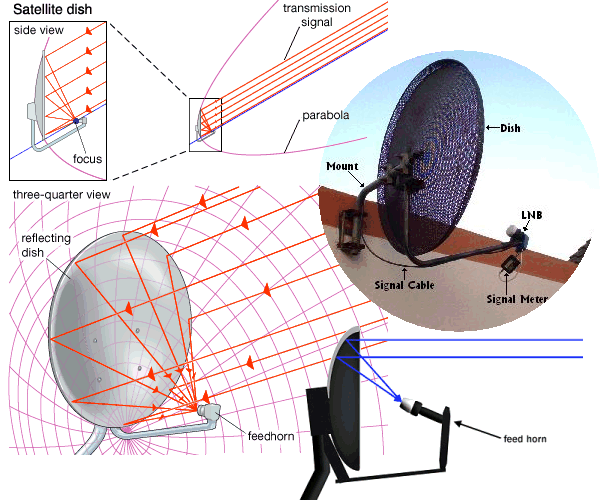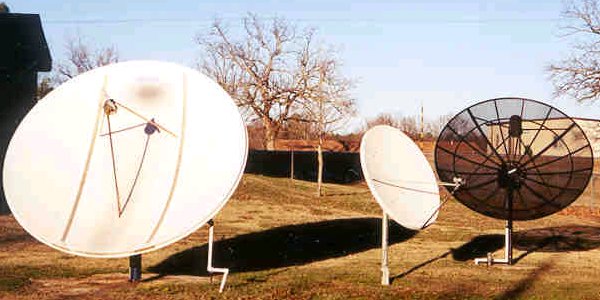Difference between revisions of "Television Satellite Dish Reference"
m (→472 x 472 cm / 186 x 186 in) |
(→Smallest Possible C-Band Dish) |
||
| (6 intermediate revisions by one user not shown) | |||
| Line 10: | Line 10: | ||
The central element in the feed horn is the low noise blockdown converter, or LNB. The LNB amplifies the radio signal bouncing off the dish and filters out the noise (radio signals not carrying programming). The LNB passes the amplified, filtered signal to the satellite receiver inside the viewer's house. | The central element in the feed horn is the low noise blockdown converter, or LNB. The LNB amplifies the radio signal bouncing off the dish and filters out the noise (radio signals not carrying programming). The LNB passes the amplified, filtered signal to the satellite receiver inside the viewer's house. | ||
| + | |||
| + | | ||
| + | |||
| + | == Satellite TV Downlink Dishes == | ||
| + | |||
| + | The photograph below shows a small dish farm at the Army National Guard - Camp Robinson, in Little Rock, Arkansas. | ||
| + | |||
| + | [[Image:ArmyNatGuCRLittleRock.jpg]] | ||
| + | |||
| + | The solid dish on the left and the mesh dish on the right are steerable C/Ku analog dishes that use the older, but still very viable analog satellite signals. The operators are able to rotate these dishes across the "Van Allen" arc to capture unscrambled programming from satellites like Galaxy 6, Spacenet 4, SBS6, or the Telstar Series. These satellites are operated by companies like Hughes, PanAmSat or Loral. | ||
| + | |||
| + | The center dish is a fixed ground mounted Compressed Digital Video (CDV) dish that does not move. It is focused on only one satellite (Telstar 4) that services the military and Government and Education Training Networks. It’s programming signal is digital and is encrypted or closed to public use. | ||
| | ||
| Line 177: | Line 189: | ||
=== 305 x 305 cm / 120 x 120 in === | === 305 x 305 cm / 120 x 120 in === | ||
| − | ''( | + | ''(3 meter / 10 ft)'' |
{| | {| | ||
| [[Image:tvsatdishref0014.jpg]] | | [[Image:tvsatdishref0014.jpg]] | ||
| Line 184: | Line 196: | ||
. | . | ||
| − | === | + | === 366 x 366 cm / 144 x 144 in === |
| − | ''(3. | + | ''(3.7 meter / 12 ft)'' |
{| | {| | ||
| − | | [[Image: | + | | [[Image:tvsatdishref0016.jpg]] |
| − | | Example: <BR><BR> | + | | Example: <BR><BR>12 foot C band Satellite Dish <BR><BR>''(prime focus)'' |
|} | |} | ||
. | . | ||
| + | |||
=== 472 x 472 cm / 186 x 186 in === | === 472 x 472 cm / 186 x 186 in === | ||
''(4.7 meter / 14 ft)'' | ''(4.7 meter / 14 ft)'' | ||
| Line 199: | Line 212: | ||
. | . | ||
=== 500 x 500 cm / 196 x 196 in === | === 500 x 500 cm / 196 x 196 in === | ||
| − | ''( | + | ''(5 meter / 16.5 ft)'' |
{| | {| | ||
| [[Image:tvsatdishref0015.jpg]] | | [[Image:tvsatdishref0015.jpg]] | ||
| Line 215: | Line 228: | ||
A dual-band or Ku band LNB may be retrofitted to some big dishes, however there is a more restrictive maximum mesh size (anything less than the diameter of a pencil) if anything other than a solid dish is used at these shorter wavelengths. Usually, a solid fiberglass or spun aluminum dish is ideal for dual-band LNB operation. | A dual-band or Ku band LNB may be retrofitted to some big dishes, however there is a more restrictive maximum mesh size (anything less than the diameter of a pencil) if anything other than a solid dish is used at these shorter wavelengths. Usually, a solid fiberglass or spun aluminum dish is ideal for dual-band LNB operation. | ||
| − | + | C band is in the microwave range of frequencies ranging from 4 to 8 GHz. It was the first frequency band allocated for commercial ground-to-satellite communications. A typical C-band satellite uses 3.7–4.2 GHz for downlink, and 5.925–6.425 Ghz for uplink. C band is often used for Television receive-only, or TVRO, as discussed here. | |
| − | + | If you're looking for C band equipment, consider buying used. Due to the popularity of digital satellite systems, people are selling or sometimes giving away their old C band equipment. Two excellent, used receiver brands to look for are General Instrument, Drake, and Uniden. Avoid systems made prior to around 1992, off brand equipment, and broken systems. Popular brands will usually mean that a large stockpile of repair parts are available. Refer to our [[C-Band Satellite Information]] page for more details. | |
| − | + | Ku Band is also in the microwave range of frequencies. It ranges from 12.0 to 18.0 GHz. Ku band satellites are also used for backhauls and particularly for satellite from remote locations back to a television network's studio for editing and broadcasting. The 12.2 to 12.7 GHz (LOF 11.250 GHz) segment is allocated to the BSS (broadcasting satellite service). BSS/DBS direct broadcast satellites normally carry 16 to 32 transponders of 27 MHz bandwidth running at 100 to 240 watts of power, allowing the use of receiver antennas as small as 18 inches (450 mm). | |
| − | + | | |
| − | |||
| − | |||
| | ||
Latest revision as of 11:18, 2 January 2008
A Satellite Dish is a type of antenna. Satellite dishes are often shaped like portions of a paraboloid (a parabola rotated about its central axis) in order to focus transmission signals onto the pickup receiver, or feedhorn. Typically, the section of the paraboloid used is offset from the centre so that the feedhorn and its support do not unduly block signals to the reflecting dish.
A satellite dish works similar to a TV antenna with the exception that it is intended to pick-up the weak ultra high frequency satellite transmissions, down-convert the frequency and place them on the coaxial cable. The Dish is made up of several components – The dish itself, an LNB and an actuator for motorised dishes.
The receiving dish works in the exact opposite way of the transmitter. When a beam hits the curved dish, the parabola shape reflects the radio signal inward onto a particular point, just like a concave mirror focuses light onto a particular point. The point is the dish's feed horn, which passes the signal on to the receiving equipment. In an ideal setup, there aren't any major obstacles between the satellite and the dish, so the dish receives a clear signal.
In some systems, the dish needs to pick up signals from two or more satellites at the same time. The satellites may be close enough together that a regular dish with a single horn can pick up signals from both. This compromises quality somewhat, because the dish isn't aimed directly at one or more of the satellites. A new dish design uses two or more horns to pick up different satellite signals. As the beams from different satellites hit the curved dish, they reflect at different angles so that one beam hits one of the horns and another beam hits a different horn.
The central element in the feed horn is the low noise blockdown converter, or LNB. The LNB amplifies the radio signal bouncing off the dish and filters out the noise (radio signals not carrying programming). The LNB passes the amplified, filtered signal to the satellite receiver inside the viewer's house.
Contents
- 1 Satellite TV Downlink Dishes
- 2 How to calculate what size dish you need
- 3 Illustrated Dish Sizes
- 3.1 34 x 39 cm / 13.5 x 15.5 in
- 3.2 46 x 46 cm / 18 x 18 in
- 3.3 50.8 x 50.8 cm / 20 x 20 in
- 3.4 60 x 60 cm / 24 x 24 in
- 3.5 78.5 x 60.5 cm / 30.9 x 23.8 in
- 3.6 85 x 85 cm / 33.5 x 33.5 in
- 3.7 90 x 90 cm / 35.4 x 35.4 in
- 3.8 90 x 90 cm / 36 x 36 in
- 3.9 99 x 99 cm / 39 x 39 in
- 3.10 180 x 180 cm / 70.9 x 70.9 in
- 3.11 230 x 230 cm / 90 x 90 in
- 3.12 305 x 305 cm / 120 x 120 in
- 3.13 366 x 366 cm / 144 x 144 in
- 3.14 472 x 472 cm / 186 x 186 in
- 3.15 500 x 500 cm / 196 x 196 in
- 4 BUD: Big Ugly Dish
Satellite TV Downlink Dishes
The photograph below shows a small dish farm at the Army National Guard - Camp Robinson, in Little Rock, Arkansas.
The solid dish on the left and the mesh dish on the right are steerable C/Ku analog dishes that use the older, but still very viable analog satellite signals. The operators are able to rotate these dishes across the "Van Allen" arc to capture unscrambled programming from satellites like Galaxy 6, Spacenet 4, SBS6, or the Telstar Series. These satellites are operated by companies like Hughes, PanAmSat or Loral.
The center dish is a fixed ground mounted Compressed Digital Video (CDV) dish that does not move. It is focused on only one satellite (Telstar 4) that services the military and Government and Education Training Networks. It’s programming signal is digital and is encrypted or closed to public use.
How to calculate what size dish you need
For Ku band reception within most of the continental US you can use a 75cm dish (2 1/2 foot). Fringe areas may need a 90cm or larger dish depending on which satellite your trying to obtain signal from. You can use this chart to double check to see if a 75cm dish will be large enough.
Having problems with a local city ordinance regulating dish size? That ordinance may be unenforceable! The FCC has passed rules to allow you to use up to a 39.37 inch dish (1 meter or 100 centimeters). The FCC rules may over ride any local regulations imposed on you.
| C-Band | Ku-Band | ||||
|---|---|---|---|---|---|
| EIRP (dBW) |
C Band Dish Size (meters) |
C Band Dish Size (Feet) |
EIRP (dBW) |
KU Dish Size (centimeter) |
KU Dish Size (inches) |
| 39.0 | 1.9 | 6.2 | 50.0 | 55 | 21.65 |
| 38.0 | 2.1 | 6.8 | 49.0 | 60 | 23.62 |
| 37.0 | 2.3 | 7.5 | 48.0 | 65 | 25.59 |
| 36.0 | 2.6 | 8.5 | 47.0 | 72 | 28.35 |
| 35.0 | 2.8 | 9.1 | 46.0 | 77 | 30.31 |
| 34.0 | 3.1 | 10.1 | 44.0 | 95 | 37.40 |
| 33.0 | 3.5 | 11.4 | 42.0 | 115 | 45.28 |
| 32.0 | 3.9 | 12.8 | 40.0 | 138 | 54.33 |
| 31.0 | 4.3 | 14.1 | 38.0 | 175 | 68.90 |
EIRP - Abbreviation for Effective-Isotropic-Radiated-Power
C Band - the frequencies in the 4 to 6 GHz range used both for terrestrial microwave links and satellite links
Ku Band - the frequency range from 10.5 to 17 GHz; in satellite communications, the frequency band 13.75 to 14.50 GHz for transmission, and 10.7 to 12.75 GHz for reception
Bigger is better and in fringe areas a slightly over sized dish will perform better in sever weather. For example, using a 1.2 meter dish in an area where a .98 meter dish would get you by can make a big difference in signal strength, clarity, and reliability.
Illustrated Dish Sizes
sizes in width x height metric and us. .
34 x 39 cm / 13.5 x 15.5 in
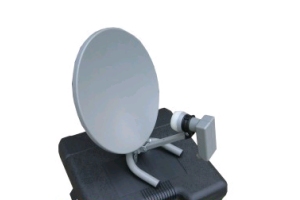
|
Example: Portable Camping Satellite Dish claims to have same signal strenght as an 18" dish this one includes dual LNB |
.
46 x 46 cm / 18 x 18 in
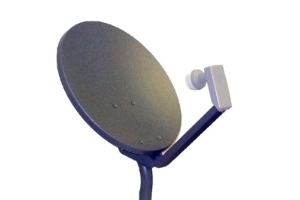
|
Example: Ariza single LNB dish |
.
50.8 x 50.8 cm / 20 x 20 in
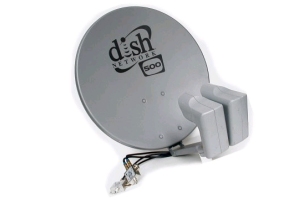
|
Example: Dish Network DISH 500 Antenna 20" Winegard Satellite DishPro Twin (for 110, 119) |
.
60 x 60 cm / 24 x 24 in
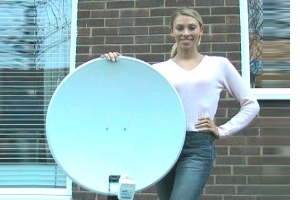
|
Example: Triax TD64 dish |
.
78.5 x 60.5 cm / 30.9 x 23.8 in
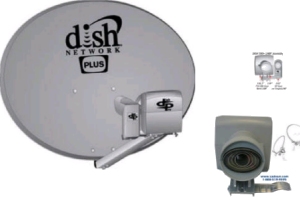
|
Example: Dish Network DISH 500 Plus Antenna |
.
85 x 85 cm / 33.5 x 33.5 in
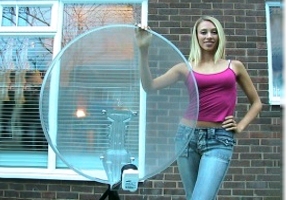
|
Example: Transparent 85cm dish |
.
90 x 90 cm / 35.4 x 35.4 in
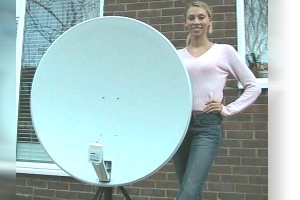
|
Example: Triax TD 78 |
.
90 x 90 cm / 36 x 36 in
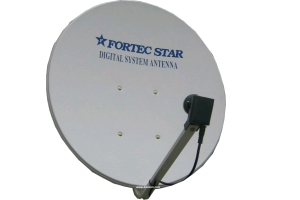
|
Example: Fortec Star 90U Ku Offset Dish Antenna & Sadoun Standard KUL1 LNBF |
.
99 x 99 cm / 39 x 39 in
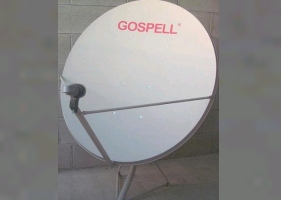
|
Example: 39" GOSPELL Ku band dish with DSS LNB Gain(>40dB at 12.5G) |
.
180 x 180 cm / 70.9 x 70.9 in
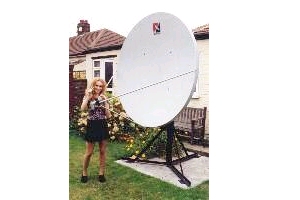
|
Example: 1.8m offset fixed Channel Master dish |
.
230 x 230 cm / 90 x 90 in
(2.3 meter / 7.5 ft)
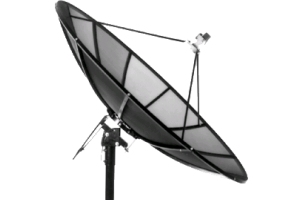
|
Example: 7.5' ft C/Ku Band Antenna F/D Ratio .38, Mainlobe Beamwidth: * C Band: 2.138 degrees, * Ku Band: .76 degrees Intermediate Band (prime focus) |
.
305 x 305 cm / 120 x 120 in
(3 meter / 10 ft)
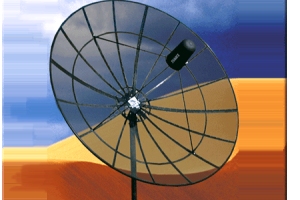
|
Example: Sami CBAND 10ft Polar Mount # C Band: 1.749 degrees # Ku Band .583 degrees Weight: 105 pounds (prime focus) |
.
366 x 366 cm / 144 x 144 in
(3.7 meter / 12 ft)
| File:Tvsatdishref0016.jpg | Example: 12 foot C band Satellite Dish (prime focus) |
.
472 x 472 cm / 186 x 186 in
(4.7 meter / 14 ft)
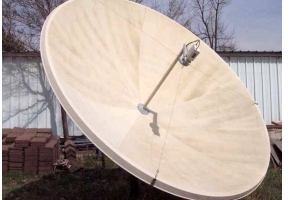
|
Example: 14' fiberglass (prime focus) |
.
500 x 500 cm / 196 x 196 in
(5 meter / 16.5 ft)
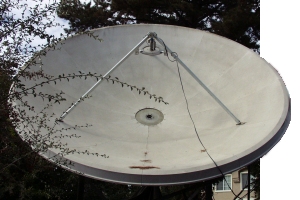
|
Example: 5 meter dish (prime focus) |
.
BUD: Big Ugly Dish
A big ugly dish (often abbreviated to BUD) is a colloquial name for a satellite dish used to receive satellite television signals from FSS-type satellites on the C band. BUDs are usually about ten feet or three metres in diameter and have been a source of much consternation (even local zoning disputes) to neighbors of those with the dishes. Although some dishes are made of fiberglass, a common alternative is a metal mesh — such BUDs shed snow and suffer reduced wind loads; in addition, some critics consider them less unsightly.
Recently, DBS services have reduced or eliminated the need for BUDs. Signals from DBS satellites (operating in the Ku band) are higher in power and therefore require smaller dishes than C band, and the digital signals now used require far less signal strength at the receiver. General advancements in noise abatement have also had an effect. For these reasons, significantly smaller dishes are now used for home satellite reception.
A dual-band or Ku band LNB may be retrofitted to some big dishes, however there is a more restrictive maximum mesh size (anything less than the diameter of a pencil) if anything other than a solid dish is used at these shorter wavelengths. Usually, a solid fiberglass or spun aluminum dish is ideal for dual-band LNB operation.
C band is in the microwave range of frequencies ranging from 4 to 8 GHz. It was the first frequency band allocated for commercial ground-to-satellite communications. A typical C-band satellite uses 3.7–4.2 GHz for downlink, and 5.925–6.425 Ghz for uplink. C band is often used for Television receive-only, or TVRO, as discussed here.
If you're looking for C band equipment, consider buying used. Due to the popularity of digital satellite systems, people are selling or sometimes giving away their old C band equipment. Two excellent, used receiver brands to look for are General Instrument, Drake, and Uniden. Avoid systems made prior to around 1992, off brand equipment, and broken systems. Popular brands will usually mean that a large stockpile of repair parts are available. Refer to our C-Band Satellite Information page for more details.
Ku Band is also in the microwave range of frequencies. It ranges from 12.0 to 18.0 GHz. Ku band satellites are also used for backhauls and particularly for satellite from remote locations back to a television network's studio for editing and broadcasting. The 12.2 to 12.7 GHz (LOF 11.250 GHz) segment is allocated to the BSS (broadcasting satellite service). BSS/DBS direct broadcast satellites normally carry 16 to 32 transponders of 27 MHz bandwidth running at 100 to 240 watts of power, allowing the use of receiver antennas as small as 18 inches (450 mm).
